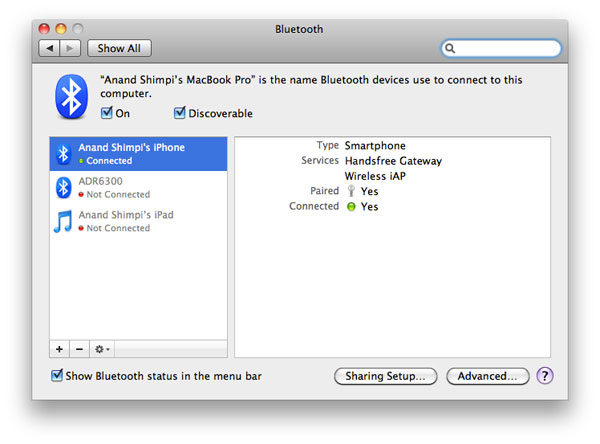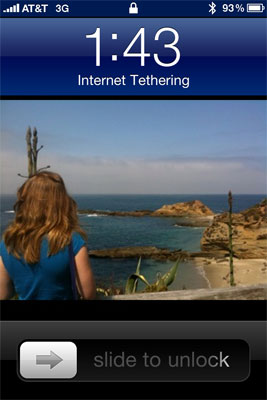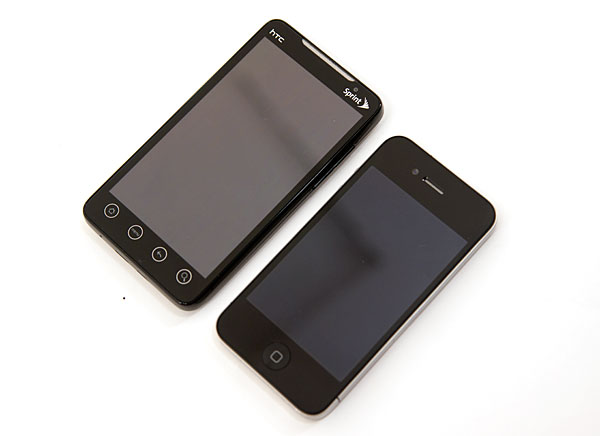Apple's iPhone 4: Thoroughly Reviewed
by Brian Klug & Anand Lal Shimpi on June 30, 2010 4:06 AM EST- Posted in
- Smartphones
- Apple
- iPhone 4
- Gadgets
- Mobile
Living with the 4
Thus far the majority of this article has focused on the technical details of the new iPhone both in its advancements and shortcomings, but what is it like to live with?
As I implied in the introduction, the 4 makes the previous iPhone feel very old. But in day to day use it doesn’t feel much different. It uses the same iOS that iPhone 3GS users get access to so with the exception of FaceTime and camera improvements, the iPhone 4 is functionally the same as its predecessor. That’s an important thing to keep in mind because to a 3GS owner it makes the iPhone not feel any different.

We've already covered iOS 4 extensively so there's no point in rehashing that here. The only new experience we have to add is our time with tethering.
The option to enable tethering is unfortunately buried in iOS 4's settings. You need to go into general settings, then network and then Internet tethering. You also need to either have Bluetooth enabled or be connected via USB to the computer you wish to tether.

You of course need to have tethering enabled on your plan, which you can't do from the settings menu. You either have to call AT&T or add the plan via attwireless.com. From there just connect to the 4 and you can use it as a modem. The phone can even be locked while tethered. Once enabled it ranges from a lifesaver to a total waste of money depending on AT&Ts coverage.

Getting used to the size of the new iPhone isn't hard at all. The device is a lot thinner which makes two handed portrait operation more strenuous especially if you're typing a lot on it. The 4 is going to be one great gaming device because holding it in landscape mode feels awesome. Overall I'd say the size feels right.
The glass everywhere is nice. It does make it impossible to quickly tell which side is front when you're fumbling around your pocket looking for it though. And I still feel like I'm going to drop and break the thing in no time at all. While not as slick as the 3GS' plastic, the stainless steel and glass aren't exactly the most grippy surfaces.
The higher res screen makes even sending text messages clearer. Everything is just so much more crisp.

Browsing the web is more pleasant as well, but tiny text is still tiny text regardless of how sharp the display is. You'll still need to zoom in on regular sites.
You do get used to the screen though. It's only when going back to the 3GS that the 4 feels new again. It's sort of like an SSD, you miss the retina display when it's gone.
The seat of the pants feel has definitely improved thanks to the A4. Although, I'd say its subtle. Web pages load quicker, animations are smoother. It's not perfect however. There are still some choppy animations and pauses from the scheduler giving too much CPU time to a hungry process. In general though, the phone feels like it was designed to run iOS 4 while the 3GS can get a bit overwhelmed at times.

The OS improvements, although not specific to the 4, are still lacking in two key areas. Apple still hasn't implemented a good notification system ala Android or webOS. I expected that update with iOS 4 but I guess we'll get it next year instead.
Secondly the multitasking interface is nice but still not quite perfect. I am still holding out for either an improved webOS or for Apple to do it's own take on the card system.
How does the 4 compare to Android? The same differences are still there. Currently there is no Android phone quite as sleek as the iPhone 4, although I expect that could change in less than a year.
The latest Android phones have had better cameras and higher resolution screens, so the iPhone 4 doesn't have as huge of an advantage there.
Apple still has the UI polish down pat. Scrolling is far smoother and performance more consistent, although I believe Google isn't far away from fixing this. The Froyo update alone does wonders to performance. If Google could fix the scrolling issues I'd say a number of iPhone users would for sure be fine with switching.

There is this more open, more configurable, more capable feel you get with Android that you don't with the iPhone. That can be both a positive and a negative. Android phones feel more like computers while iPhones have more of that appliance feel. It still boils down to personal preference, the 4 won't change that.










270 Comments
View All Comments
strikeback03 - Tuesday, July 6, 2010 - link
How does international work? Are other parts of Europe covered by that as well or are they all additional?B3an - Thursday, July 1, 2010 - link
Theres way WAY less options for network and internet providers in the U.S, especially compared to here in the U.K..So less competition means higher prices. And of course the size of the U.S/Canada is a problem.
strikeback03 - Thursday, July 1, 2010 - link
Some friends who have been living in England say that cell usage over there is way more expensive. They claim the only affordable way to do it is with pay as you go SIMs and just not use them much.But yes more competition would be nice. For me Verizon is the only carrier that offers the kind of coverage I need. So between the fact that I can't go anywhere and that they don't offer an off-contract rate I have no reason not to take the subsidized phones and contract extensions.
Chissel - Sunday, July 4, 2010 - link
I'm an American living in the UK. iPhone 4 rates here are much lower. The best I have seen is from Tesco (o2 network). Low cost no frills service. 750 minutes + unlimited texts + 1gb of data per month. Also, incoming calls do not charge minutes. 1 yr. contract 32gb iPhone 4 = £299/$450 + £35/$50 per month (all tax included). After 1 yr. they have to unlock your phone. After you unlock the phone you can drop down to £20/$30 per month.This means the 2 year cost of the phone + service in the UK is £959/$1,438. In the US the 2 year cost is $299 + tax and $105/mo + tax. Total cost over 2 years is $2,819 without tax.
As you can see the UK has much lower price over the 2 years. Plus, after 1 year you 'own' your phone and can resell and buy iPhone 5.
strikeback03 - Tuesday, July 6, 2010 - link
I think the unlock on AT&T can be requested after 3 months, definitely after a year as I had a friend do that.StormyParis - Saturday, July 3, 2010 - link
I've abandonned data plans, and switched back to plain voice, on my HD2. I get Wifi most everywhere (at home and at work for sure, and most places in between). I was simply not using data that much, it's not worth the monthly 30 euros they want for it.99.5% of the time, there's no difference at all. 0.5% of the time... i can survive...
vol7ron - Wednesday, June 30, 2010 - link
I agree, but..."The fact that Apple didn't have the foresight to coat the stainless steel antenna band with even a fraction of an ounce worth of non-conductive material either tells us that Apple doesn't care or that it simply doesn't test thoroughly enough. The latter is a message we've seen a few times before with OS X issues..."
Apple would just see this as another selling point for the bumper.
Anand/Brian-
I'm curious if you've had a chance to test with the microfilm covers like Bodyguardz or Zagg.
I use these because of how thin they are and how great they are at protecting the device (scratch free even when dropping on concrete). They cover all points of the phone rather effectively. I'm curious if they would be beneficial to your testing.
vol7ron
Brian Klug - Wednesday, June 30, 2010 - link
vol7ron,You're totally right, I need to test with a thin film or some heavy duty tape/invisible shield. I originally thought of doing that, but somehow it got lost in all that frenzied testing. I'll whip something up and see if anything changes. I mean that's a good point too, it might not do very much.
I mean, ultimately there's a thickness you do need to achieve, and to be fair a lot of the benefit the case adds is that extra couple mm or two from the antenna. If the film is too thin, it might not do much. What makes me uneasy about saying anything definitively is that this is so near field - literally on top of the radiative surface. I'll admit I have only a basic level of understanding about what kind of interference happens in the very near field. I mean even at 1.8 GHz, one wavelength is 16 cm - the case and your hands on the phone is way inside near field.
-Brian
rainydays - Wednesday, June 30, 2010 - link
Agree. Outstanding review. The detailed analysis and level headed tone is excellent. Keep up the great work.Antenna section was illuminating. Good point about using SNR. I wonder if that number by itself is sufficient though. I guess signal power in dbm along with SNR would give the most complete picture of reception.
At any rate, as is abundantly clear in the article, you never really know where you are till you see the numbers.
John Sawyer - Thursday, July 1, 2010 - link
Yes, the numbers, details, etc. are more important than a lot of people realize. It often annoys me when I see people commenting about issues that involve actual measurement, technical facts, etc., without referring to any of those, and thus winding up with all kinds of conspiracy theories, bogus suggestions, etc. As applied to hardware problems from any manufacturer, generally many such commenters, in their understandable desire to just see a fix for a problem, wind up suggesting the only important thing is for the manufacturer to set up a return exchange program, which would be nice if it were always that easy, but it doesn't address the details of the problem that are often quite interesting, and can be very useful for people trying to learn from the situation.